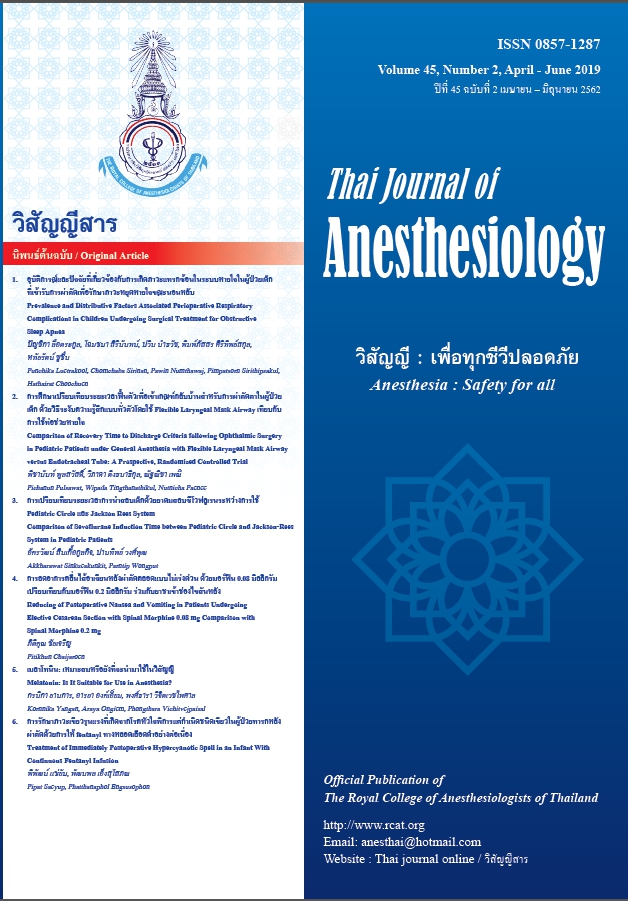Comparison of Sevoflurane Induction Time between Pediatric Circle and Jackson-Rees System in Pediatric Patients
Main Article Content
Abstract
Background: A Jackson Rees (JR), compared with a
pediatric circle (PC), system has lower capacity and time
constant leading to shorter induction time, thus making it
circuit of choice for induction. However, during maintenance
using low flow anesthesia, a JR is inappropriate due to the
need of very high fresh gas flow. At Srinagarind Hospital,
sevoflurane induction in pediatric patient without
premedication and intravenous access is usually
performed using a JR system and then switch to a PC
system during maintenance. This switching procedure
increases risk of error; so some anesthesiologists prefer
using a PC system solely to prevent error.
Objectives: To compare sevoflurane induction time
between a PC system and JR system.
Methods: Fifty-six pediatric patients without premedication
and intravenous access were randomized and allocated
into 2 groups; PC group (28 patients) and JR group
(28 patients). Both systems were primed with 8%
sevoflurane with 67% nitrous oxide in oxygen with a total
flow rate of 6 LPM before starting induction. Time to loss
of eyelash reflex, intravenous cannulation, central pupils,
as well as patients’ movement during intravenous
cannulation and adverse effects were recorded and
compared.Results: Time to loss of eyelash reflex of PC group was
significantly longer than JR group (69.14±27.36 vs.
51.03±12.30 sec, respectively; p<0.05). No statistical
difference was found in time to intravenous cannulation,
central pupils, as well as patients’ movement during
intravenous cannulation and adverse effects between both
groups.
Conclusion: Sevoflurane induction time using PC system
was significantly, slightly longer than JR system (mean
difference 18.1 sec; 95% CI = 6.63-29.59 sec.). There is
no significant difference in time to intravenous cannulation
as well as patients’ movement during intravenous
cannulation and adverse effects. So clinical implement is
capable.
Article Details
References
Distress during the induction of anesthesia and postoperative
behavioral outcomes. Anesth Analg 1999; 88: 1042-7.
2. Varughese AM, Hagerman N, Patino M, et al. A comparison
of inhalational inductions for children in the operating room
vs the induction room. Pediatric Anesthesia 2012; 22: 327-34.
3. Baum VC, Yemen TA, Baum LD. Immediate 8% sevoflurane
induction in children: a comparison with incremental
sevoflurane and incremental halothane. Anesth Analg
1997; 85(2): 313-6.
4. Dubois MC, Piat V, Constant I, Lamblin O, Murat I. Comparison
of three techniques for induction of anaesthesia with
sevoflurane in children. Paediatr Anaesth 1999; 9(1):19-23.
5. Meretoja, OA, Taivainen T, Räihä L, Korpela R, Wirtavuori K.
Sevoflurane-nitrous oxide or halothane-nitrous oxide for
paediatric bronchoscopy and gastroscopy. Br J Anaesth
1996; 76(6): 767-71.
6. Taivainen T, Tiainen P, Meretoja OA, Räihä L, Rosenberg
PH. Comparison of the effects of sevoflurane and halothane
on the quality of anaesthesia and serum glutathione
transferase alpha and fluoride in paediatric patients. Br J
Anaesth 1994; 73(5): 590-5.
7. Chawathe M, Zatman T, Hall JE, et al. Sevoflurane (12% and
8%) inhalational induction in children. Paediatr Anaesth 2005;
15(6): 470-5.
Singh PM, Trikha A, Sinha R, Rewari V, Ramachandran R,
Borle A. Sevoflurane induction procedure: cost comparison
between fixed 8% versus incremental techniques in pediatric
patients.AANA Journal 2014; 82(1): 32-7.
9. Martin-Larrauri R, Gilsanz F, Rodrigo J, Vila P, Ledesma M,
Casimiro C. Conventional stepwise vs. vital capacity rapid
inhalation induction at two concentrations of sevoflurane. Eur
J Anaesthesiol 2004;21(4): 265-71.
10. Mendonca C, Thorpe C. Effect of smoking on induction of
anaesthesia with sevoflurane. Anaesthesia 2001; 56(1): 19-23.
11. Rees JG. Anaesthesia in the Newborn. BMJ 1950; 2: 1419-22.
12. Lindahl SG, Charlton AJ, Hatch DJ, Phythyon JM. Ventilatory
responses to inspiratory mechanical loads in spontaneously
breathing children during halothane anaesthesia. Acta
Anaesthesiol Scand 1986;30(2): 122-7.
13. Conterato JP, Lindahl SGE, Meyer DM, Bires JA. Assessment
of spontaneous ventilation in anesthetized children with use
of a pediatric circle or a Jackson-Rees system. Anesth Analg
1989; 69(4): 484-90.
14. Nakae Y, Miyabe M, Sonoda H, Tamiya K, Namiki A.
Comparison of the Jackson-Rees circuit, the pediatric circle,
and the MERA F breathing system for pediatric anesthesia.
Anesth Analg 1996; 83: 488-92.
15. Fernandez M, Lejus C, Rivault O, et al. Single breath vital
capacity rapid inhalation induction with sevoflurane:
feasibility in children. Paediatr Anaesth 2005; 15(4): 307-13.
16. Lejus C, Bazin V, Fernandez M, et al. Inhalation induction
using sevoflurane in children: the single breath vital capacity
technique compared to the tidal volume technique.
Anaesthesia 2006; 61(6): 535-40.
17. Rasch DK, Bunegin L, Ledbetter J, Kaminskas D. Comparison
of circle absorber and Jackson-Rees system for paediatric
anaesthesia. Can J Anaesth 1998; 35(1): 25-30.

